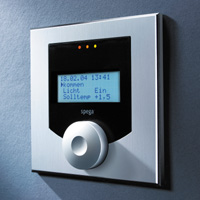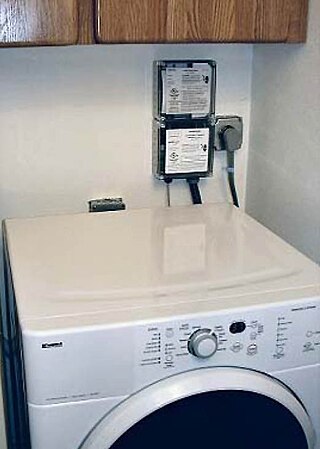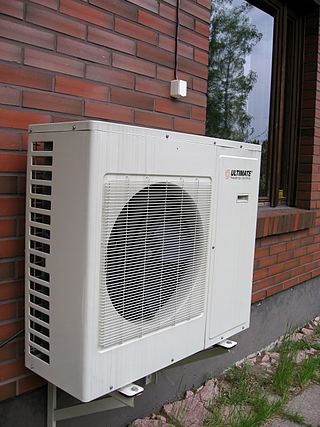
Home automation or domotics is building automation for a home. A home automation system will monitor and/or control home attributes such as lighting, climate, entertainment systems, and appliances. It may also include home security such as access control and alarm systems.

Automatic meter reading (AMR) is the technology of automatically collecting consumption, diagnostic, and status data from water meter or energy metering devices and transferring that data to a central database for billing, troubleshooting, and analyzing. This technology mainly saves utility providers the expense of periodic trips to each physical location to read a meter. Another advantage is that billing can be based on near real-time consumption rather than on estimates based on past or predicted consumption. This timely information coupled with analysis can help both utility providers and customers better control the use and production of electric energy, gas usage, or water consumption.

An electricity meter, electric meter, electrical meter, energy meter, or kilowatt-hour meter is a device that measures the amount of electric energy consumed by a residence, a business, or an electrically powered device.

Demand response is a change in the power consumption of an electric utility customer to better match the demand for power with the supply. Until the 21st century decrease in the cost of pumped storage and batteries, electric energy could not be easily stored, so utilities have traditionally matched demand and supply by throttling the production rate of their power plants, taking generating units on or off line, or importing power from other utilities. There are limits to what can be achieved on the supply side, because some generating units can take a long time to come up to full power, some units may be very expensive to operate, and demand can at times be greater than the capacity of all the available power plants put together. Demand response, a type of energy demand management, seeks to adjust in real-time the demand for power instead of adjusting the supply.

CenterPoint Energy, Inc. is an American electric and natural gas utility serving several markets in the American states of Indiana, Ohio, Louisiana, Minnesota, Mississippi, and Texas. Part of the Fortune 500, the company was formerly known as Reliant Energy, NorAm Energy, Houston Industries, and HL&P. The company is headquartered in the CenterPoint Energy Tower at 1111 Louisiana Street in Downtown Houston.

Negawatt power is investment to reduce electricity consumption rather than investing to increase supply capacity. In this way investing in negawatts can be considered as an alternative to a new power station and the costs and environmental concerns can be compared.

A smart meter is an electronic device that records information—such as consumption of electric energy, voltage levels, current, and power factor—and communicates the information to the consumer and electricity suppliers. Such an advanced metering infrastructure (AMI) differs from automatic meter reading (AMR) in that it enables two-way communication between the meter and the supplier.

Sempra is a North American public utility holding company based in San Diego, California. The company is one of the largest utility holding companies in the United States with nearly 40 million consumers. Sempra's focus is on electric and natural gas infrastructure and its operating companies include: Southern California Gas Company (SoCalGas) and San Diego Gas & Electric (SDG&E) in Southern California; Oncor Electric Delivery Company in Texas; and Sempra Infrastructure, with offices in California.

The smart grid is an enhancement of the 20th century electrical grid, using two-way communications and distributed so-called intelligent devices. Two-way flows of electricity and information could improve the delivery network. Research is mainly focused on three systems of a smart grid – the infrastructure system, the management system, and the protection system. Electronic power conditioning and control of the production and distribution of electricity are important aspects of the smart grid.

Itron is an American technology company that offers products and services for energy and water resource management. It is headquartered in Liberty Lake, Washington, United States. The company's products measure and analyze electricity, gas and water consumption. Its products include electricity, gas, water and thermal energy measurement devices and control technology, communications systems, software, as well as managed and consulting services.

A home energy monitor is a device that provides information about a personal electrical energy usage to a consumer of electricity. Devices may display the amount of electricity used, plus the cost of energy used and estimates of greenhouse gas emissions. The purpose of such devices is to assist in the management of power consumption. Several initiatives has been launched to increase the usage of home energy monitors. Studies have shown a reduction of home energy when the devices are used.
Shell Energy Retail Limited is a UK consumer gas, electricity and broadband provider. Formerly a subsidiary of Shell, the business was acquired by Octopus Energy in December 2023.

Oncor Electric Delivery Company is the largest transmission and distribution electric utility in the state of Texas and the 5th largest utility company in the US. Their service territory includes east, west, and north-central Texas, including Dallas, Fort Worth, Irving, Plano, Arlington, Beeville, Midland, Odessa, Killeen, Waco, Wichita Falls, Tyler, and other cities throughout Texas. In 2018, Sempra Energy acquired a majority stake in Oncor for US$9.45 billion.

AlertMe was a UK smart Tech company that provides energy and home monitoring hardware and services. AlertMe produces hardware and software to enable users to monitor and control their home energy use.

Silver Spring Networks, a subsidiary of Itron, is a provider of smart grid products, headquartered in San Jose, California, with offices in Australia, Singapore, Brazil, and the United Kingdom. Besides communications devices, Silver Spring Networks develops software for utilities and customers to improve energy efficiency. Founded in 2002 backed by venture capital, Silver Spring Networks went public on the New York Stock Exchange on March 13, 2013. Itron acquired Silver Spring Networks in January 2018 for $830 million.
The term smart grid is most commonly defined as an electric grid that has been digitized to enable two way communication between producers and consumers. The objective of the smart grid is to update electricity infrastructure to include more advanced communication, control, and sensory technology with the hope of increasing communication between consumers and energy producers. The potential benefits from a smart grid include increased reliability, more efficient electricity use, better economics, and improved sustainability.
Smart grid policy in the United States refers to legislation and other governmental orders influencing the development of smart grids in the United States.

China is the world's largest consumer of electricity, and its demand is expected to double by the next decade, and triple by 2035. In 2010, 70 percent of the country's electricity generation came from coal-fired power plants, but the Chinese government is investing heavily in renewable energy technologies. As of 2013, 21 percent of China's electricity generation comes from renewable sources. This represents only 9 percent of overall primary energy consumption in the country. China's latest goal is to increase renewable energy to 9.5 percent of overall primary energy use by 2015. To implement China's new clean energy capacity into the national power grid, and to improve the reliability of the country's existing infrastructure, requires significant upgrades and ultimately, a smart grid.

Solar power in Oklahoma can provide 44.1% of all electricity used in Oklahoma from 19,300 MW of rooftop solar panels. This scenario is extremely unlikely though because the cost of electricity in Oklahoma is among the lowest in the nation.
The UCLA Smart Grid Energy Research Center (SMERC), located on the University of California Los Angeles (UCLA) campus, is an organization focused on developing the next generation of technologies and innovation for Smart Grid. SMERC partners with government agencies, technology providers, Department of Energy (DOE) research labs, universities, utilities, policymakers, electric vehicle manufacturers, and appliance manufacturers. These partnerships provide SMERC with diverse capabilities and exceptional, mature leadership.
















